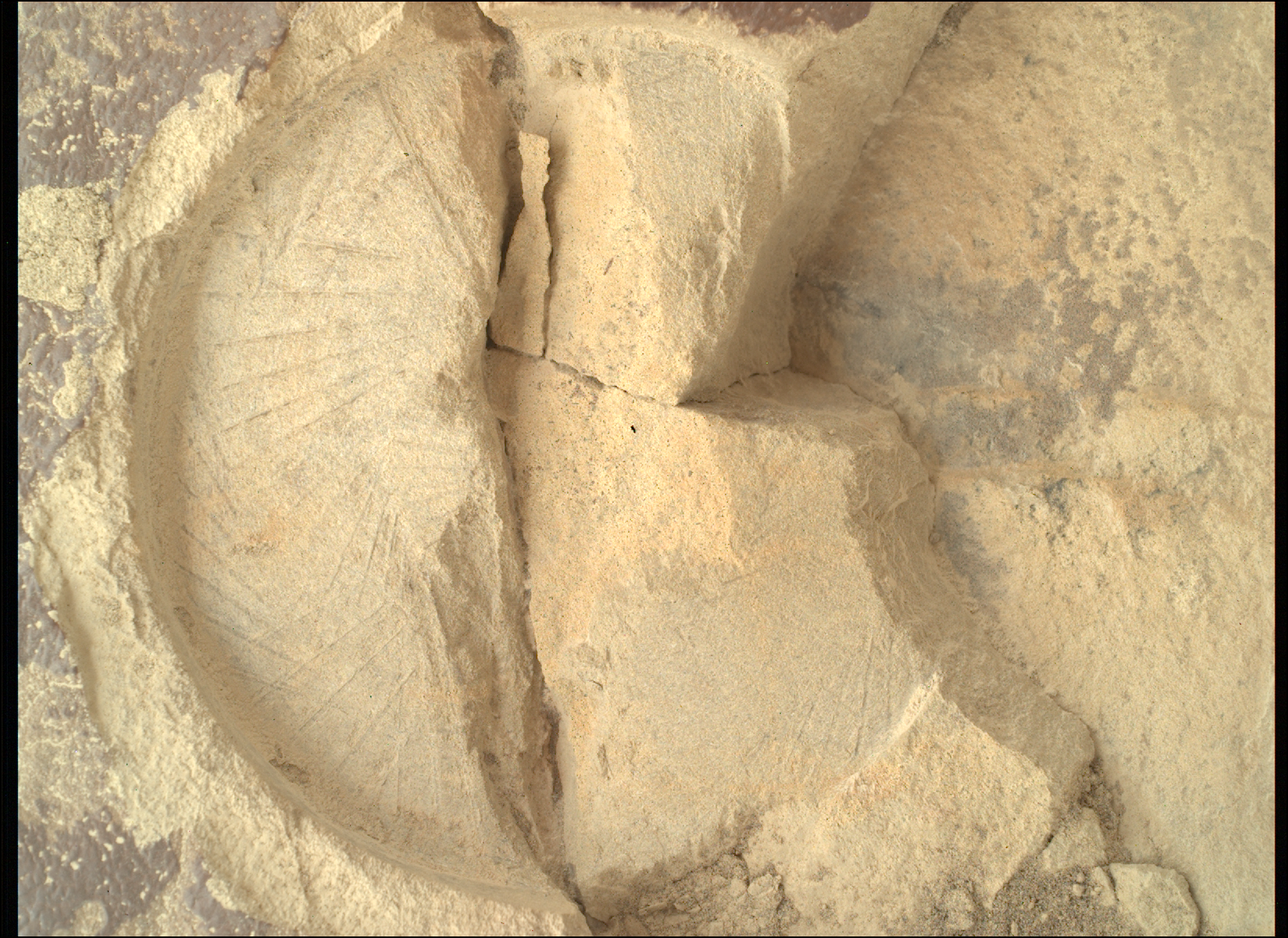2 min read
Navigating a Slanted River Finessing a fractured rock: NASA’s Mars Perseverance rover acquired this image showing the “Slants River” target, which fractured after being abraded by the rover. Perseverance captured the image using its SHERLOC WATSON camera, located on the turret at the end of the rover’s robotic arm. SHERLOC (Scanning Habitable Environments with Raman and Luminescence for Organics and Chemicals) is an instrument using cameras, spectrometers, and a laser to search for organics and minerals that have been altered by watery environments and may be signs of past microbial life. In addition to its black-and-white context camera, SHERLOC is assisted by WATSON (Wide Angle Topographic Sensor for Operations and eNgineering), a color camera for taking close-up images of rock grains and surface textures. In the case of Slants River, thanks to work by the team’s rover planners and engineers, in spite of the fracture SHERLOC was able to maneuver close to this topographically-challenging surface and conduct a spectroscopy scan. This important activity enabled the team to collect the Main River core, just next to this abrasion patch. Perseverance acquired this image on March 5, 2025 — sol 1436, or Martian day 1,436 of the Mars 2020 mission — at the local mean solar time of 14:29:29. NASA/JPL-CaltechWritten by Denise Buckner, student collaborator at University of Florida
Perseverance is hard at work on Mars, overcoming obstacles for scientific exploration! Just a few sols after successfully sealing the challenging Green Gardens core, Perseverance roved on to the Broom Point workspace to collect another sample called Main River. Broom Point is situated a few hundred meters down-slope from where Green Gardens was collected, and the Science Team chose to explore this area because orbiter images show some intriguing, alternating light and dark layers.
Upon reaching the workspace, images captured by Perseverance confirm that these distinct layers are visible on the ground, as well. Layers are interesting because they record different geological events that occurred in the planet’s past, which may include deposition of sediments, lava flows, or volcanic ash. By conducting proximity science with rover instruments and collecting a core to return to Earth for future analyses, the team is investigating what this material is composed of and how it was emplaced.
When the team is planning to collect a sample from an outcrop, the first step is to abrade the rock, grinding away the top few millimeters and smoothing out the surface so the SHERLOC and PIXL instruments can move in and conduct their scans. Although Perseverance has abraded more than 30 rocks across Jezero crater, new rocks still present unique challenges. While abrading the Slants River target at Broom Point, the rock unexpectedly fractured, resulting in an uneven surface. SHERLOC and PIXL require just a few millimeters of clearance to safely approach the rock, and while PIXL was able to reach the broken surface, the topography looked a little more dicey for SHERLOC.
The team’s engineers and rover planners took stock of the situation and decided to use WATSON, SHERLOC’s companion camera, to snap some images of the abrasion patch from another angle. These images built a surface model of the small cracks and crevices, and with this knowledge in hand, the team found a way to safely maneuver the instrument to the same spot that PIXL scanned, and collected a co-located spectroscopy map. Once this abrasion proximity science was completed, the rover went on to drill and seal the Main River core, an activity that went off without a hitch.
With another core in the bag, Perseverance is off to the next workspace, ready to tackle whatever challenges may lie ahead!
Share
Details
Last Updated Mar 13, 2025Related Terms
BlogsExplore More
2 min readSols 4477-4478: Bumping Back to Business
Article 1 day ago3 min read
Sols 4475-4476: Even the Best-Laid Plans
Article 2 days ago2 min read
Sealing the Deal
Article 7 days agoKeep Exploring
Discover More Topics From NASA
Mars
Mars is the fourth planet from the Sun, and the seventh largest. It’s the only planet we know of inhabited…
All Mars Resources
Explore this collection of Mars images, videos, resources, PDFs, and toolkits. Discover valuable content designed to inform, educate, and inspire,…
Rover Basics
Each robotic explorer sent to the Red Planet has its own unique capabilities driven by science. Many attributes of a…
Mars Exploration: Science Goals
The key to understanding the past, present or future potential for life on Mars can be found in NASA’s four…
Read More Details
Finally We wish PressBee provided you with enough information of ( Navigating a Slanted River )
Also on site :
- Watch Live: American Cardinal Robert Provost chosen as new pope
- White smoke appears over Sistine Chapel as Conclave elects new Pope
- Joanna Gaines' Crunchy-Sweet Asian Salad Is Easy to Love

